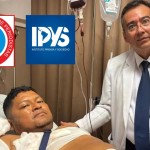The dengue outbreak that is plaguing Cuba reaches dire numbers in Guantánamo. The eastern province has the highest number of infections registered on the island, with more than 2,000 febrile cases treated in health institutions in the last week of September alone.
The municipalities of El Salvador and Baracoa report the largest increases in patients confirmed with the virus, according to a note published on friday by the official newspaper Overcome, with source in Leonel Heredia, deputy director of the Provincial Center for Hygiene, Epidemiology and Microbiology.
The epidemiologist pointed out that at the end of last September, around 1,600 deposits with mosquito larvae were registered throughout Guantánamo. Aedes aegypti, dengue transmitting agent, located in 1,301 homes in nine of the 10 municipalities that make up the province.
Heredia pointed out that the municipality of Baracoa contributed more than half of all the febrile cases registered in the province, a stage of the disease in which patients present high body temperature and other symptoms such as muscle pain, headache and facial redness.
Complicated cases also occur in La Asunción, Cabacú and La Reforma, treated at the Hermanos Martínez Tamayo Polyclinic, where patients receive focal treatments and adulticide to destroy the insect in its adult phase.
Heredia pointed out that the municipality of Baracoa contributed more than half of all the febrile cases registered in the province, a stage of the disease in which patients present high body temperature and other symptoms.
In El Salvador, which according to the note in the provincial newspaper, had maintained “discreet levels of infections”, 200 patients suspected of suffering from dengue were reported. Meanwhile, the epidemiologist warned that there is a risk of a rebound in the municipalities of Guantánamo and Caimanera, because there are several localities with declared transmission.
In the middle of last month, the Minister of Public Health, José Ángel Portal Miranda, confirmed that the risk of getting sick from dengue is high on the Island due to the high rates of infestation, and assured that in the last five weeks – between August and September – the speed of transmission of the virus had decreased, without detailing any figures that would confirm his statements.
His words came days after two health professionals died from dengue in the same week. First, the death of the physiotherapist Elba Rosa López Nápoles, in the province of Santiago de Cuba, whose family claimed that they did not give her help to take her to a care center, was confirmed, while the second case was the nurse Nelly Sánchez Espinosa, an employee of the Maternal and Child Hospital in the municipality of Cabaiguán, in the province of Sancti Spíritus.
Cuba is facing a severe outbreak of dengue infections amid the devastation caused by the passage of Hurricane Ian, which left the island without electricity for almost a week and made it impossible for families to access water or use the fan to keep away the mosquitos.
The Government affirms that the Island “is in the context of what is happening in the region.” However, the Vice Minister of Public Health, Carilda Peña García, warned last September that Cubans still have to face the “most complex moment of the disease” because the cycle shows its greatest peaks from the end of October and the beginning of november.
________________________
Collaborate with our work:
The team of 14ymedio is committed to doing serious journalism that reflects the reality of deep Cuba. Thank you for joining us on this long road. We invite you to continue supporting us, but this time becoming a member of our journal. Together we can continue transforming journalism in Cuba.


















